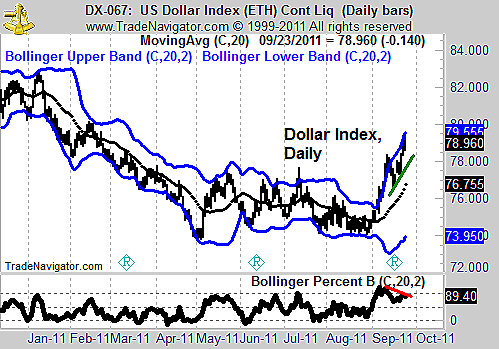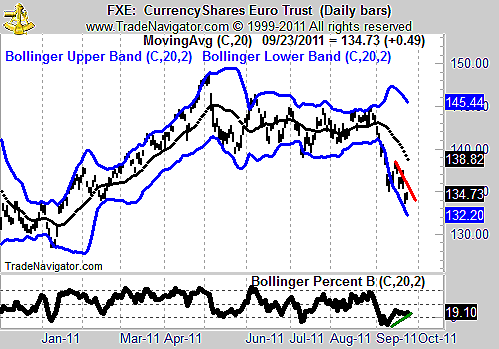
HOT TOPICS LIST
- MACD
- Fibonacci
- RSI
- Gann
- ADXR
- Stochastics
- Volume
- Triangles
- Futures
- Cycles
- Volatility
- ZIGZAG
- MESA
- Retracement
- Aroon
INDICATORS LIST
LIST OF TOPICS
PRINT THIS ARTICLE
by Mike Carr, CMT
The dollar index is heavily weighted to the euro, and both saw rapid moves after the Federal Reserve announced Operation Twist.
Position: Hold
Mike Carr, CMT
Mike Carr, CMT, is a member of the Market Technicians Association, and editor of the MTA's newsletter, Technically Speaking. He is also the author of "Smarter Investing in Any Economy: The Definitive Guide to Relative Strength Investing," and "Conquering the Divide: How to Use Economic Indicators to Catch Stock Market Trends."
PRINT THIS ARTICLE
BOLLINGER BANDS
Dollar Overbought, Euro Oversold
09/26/11 09:23:47 AMby Mike Carr, CMT
The dollar index is heavily weighted to the euro, and both saw rapid moves after the Federal Reserve announced Operation Twist.
Position: Hold
| The dollar moved quickly into overbought territory as traders seemed to be looking for a safe haven. Stocks fell just as quickly in markets around the world, and bonds were generally higher in global markets. This seems to confirm that traders wanted less risk. The Fed's announcement guaranteed demand for bonds, since the Fed was becoming a buyer. |
| Volatility increased and the dollar briefly broke through its upper Bollinger Band (Figure 1) before settling back between the bands. But the upward price action was accompanied by a Bollinger Percent B divergence. A divergence like this often precedes a price decline. |

|
| FIGURE 1: ETH, DAILY. The dollar index is sharply off its lows and the speed of the move is unusually quick for currency markets. |
| Graphic provided by: Trade Navigator. |
| |
| The euro moved almost exactly opposite to the dollar (Figure 2). It fell sharply and set up a positive divergence on the Bollinger Percent B indicator. This movement is exactly what should be expected, since the euro represents more than 50% of the dollar index. The weighting almost guarantees the two will have a strong negative correlation. In the chart, the CurrencyShares Euro Trust ETF (FXE) is shown instead of the euro futures contract because it trades with fewer gaps. The chart of the euro contract often shows gaps and narrow ranges, making the FXE chart easier to use for chart analysis. |

|
| FIGURE 2: FXE, DAILY. FXE looks oversold and potentially bullish. |
| Graphic provided by: Trade Navigator. |
| |
| Given that volatility has increased so much in the past weeks, it is likely that the dollar will consolidate recent gains rather than fall sharply. However, this is a news-driven market and anything can happen. Quick moves have become the norm. Trading a news-driven market requires tight stops, since the technicals offer only limited insights. |
Mike Carr, CMT, is a member of the Market Technicians Association, and editor of the MTA's newsletter, Technically Speaking. He is also the author of "Smarter Investing in Any Economy: The Definitive Guide to Relative Strength Investing," and "Conquering the Divide: How to Use Economic Indicators to Catch Stock Market Trends."
| Website: | www.moneynews.com/blogs/MichaelCarr/id-73 |
| E-mail address: | marketstrategist@gmail.com |
Click here for more information about our publications!
PRINT THIS ARTICLE

|

Request Information From Our Sponsors
- StockCharts.com, Inc.
- Candle Patterns
- Candlestick Charting Explained
- Intermarket Technical Analysis
- John Murphy on Chart Analysis
- John Murphy's Chart Pattern Recognition
- John Murphy's Market Message
- MurphyExplainsMarketAnalysis-Intermarket Analysis
- MurphyExplainsMarketAnalysis-Visual Analysis
- StockCharts.com
- Technical Analysis of the Financial Markets
- The Visual Investor
- VectorVest, Inc.
- Executive Premier Workshop
- One-Day Options Course
- OptionsPro
- Retirement Income Workshop
- Sure-Fire Trading Systems (VectorVest, Inc.)
- Trading as a Business Workshop
- VectorVest 7 EOD
- VectorVest 7 RealTime/IntraDay
- VectorVest AutoTester
- VectorVest Educational Services
- VectorVest OnLine
- VectorVest Options Analyzer
- VectorVest ProGraphics v6.0
- VectorVest ProTrader 7
- VectorVest RealTime Derby Tool
- VectorVest Simulator
- VectorVest Variator
- VectorVest Watchdog
